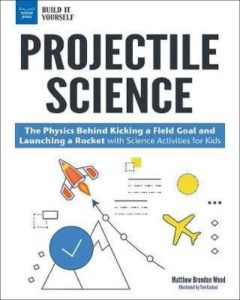“Heads Up For Projectile Science!”
I have always been fascinated by slingshots and potato cannons. Not only is there the wow factor when rock hits tree or potato hits haybale (if you’re lucky and skilled)—there’s also the challenge of guesstimating where your projectile is going to land. Because funny enough, there’s no magic involved. Just math and science.
And the same thing applies with basketballs, soccer balls, golf balls—any ball that’s been kicked, hit, tossed, or chucked is on a defined path from foot, hand, driver, to the end destination.
And what kid has never thrown a ball? None that I’ve met!
Exploring projectile science is a fantastic way to invite kids to make the connection between math, science, and their own lives. Encouraging them to discover the shape of a parabola, experiment with the laws of motion, and harness the power of mechanical energy makes for learning that lasts.
And there’s a human application beyond sports to consider when discussing projectile science. For one thing, without a sense of how your arrow is going to fly when it’s released, you’d have a lot of trouble hunting enough food to make it through a winter. While not everyone has to rely on their own weaponry skills to eat dinner these days, the historical applications of projectile science are an important aspect in the whole “When are we ever going to use this?” argument.
And for an even larger leap of the imagination—the rules of physics that govern your soccer ball are the same ones that dictate how a spaceship gets launched into space!
While educators need to make sure kids are being careful when they’re having fun with projectile science (eye protection is a must!), it’s a terrific way to get students making connections between their own experiences and the rules of mathematics.
Try these fun activities for some hands-on learning about projectile science!
ATLATL BATTLE
Different kinds of spear-throwing tools were used by ancient people around the world, but they all worked in the same basic way. It takes a lot of practice to use an atlatl, but you can make your own and try it out at home!
Warning: Never point or fire any weapon at a living creature and always wear eye protection. Ask an adult to help with the knife in this activity.
- Attach one binder clip to one end of the ruler. This is the “spur.” Fold the clip handles back.
- Using a small knife, CAREFULLY carve a notch into the eraser of each pencil. The notch should go about half way into the eraser and be wide enough to fit onto the binder clip handle. The pencils will be your darts.
- Place an eraser cap on the unsharpened end of the pencil. This will help your dart fly and be much safer!
- Place the binder handle into the notch in the eraser and lay the pencil onto the ruler lengthwise.
- Attach binder clips on either side of the pencil. These will help keep the dart from sliding off the sides of the ruler. DO NOT clip the pencil to the ruler. The pencil only needs to rest on the ruler.
- In a safe and open space, hold the ruler at the end opposite the spur. Don’t hold onto the pencil! It should only rest on the ruler.
- Keeping the ruler flat and level so the dart can’t slide out, reach back, and quickly bring the ruler forward like you’re throwing a paper airplane. Turn your wrist down at the end of the motion. Don’t let go of the ruler!
- What happened? Was the motion what you expected? Using an atlatl takes a lot of patience and practice!
Questions to think about
How is the atlatl a machine?
What forces are acting on the dart as it’s thrown?
What forces are acting on it once it’s released?
What other motions are like the one you use to throw the dart?
Try This!
Try hitting a target! How accurate can you be? What might make your dart moreaccurate? How far can you throw? Try comparing the atlatl to simply throwing your dart. Which gives you greater range? Does adding weight to the dart or the atlatl make a difference? Try making a larger atlatl to throw even larger darts. How far can you throw?
LAUNCH TIME
You don’t need a special launch pad or a million-dollar spacecraft to understand how rockets work. You can study their flight at home! All you’ll need are supplies such as string, drinking straws, and balloons.
- Attach one end of a piece of string to a sturdy object, such as a chair or doorknob, or have friend or family member hold it.
- Thread the string through one straw. Attach the other end of the string to another sturdy object. Make sure the string is level and taut.
- Blow up a balloon and pinch the opening closed—don’t tie it!
- Attach the balloon to the straw so that the balloon’s opening points along the string.
- Move the balloon and straw to one end of the string. What do you think will happen when you release the balloon?
- Release the balloon! What happens?
- Vary the experiment by inflating the balloon with more air and then less air. How does the amount of air affect the balloon’s motion?
- Now make the string vertical. What happens when you release the balloon?
Questions to think about
What direction does the balloon travel when the string is horizontal? When it’s vertical?
Can you explain what’s going on using Newton’s laws?
What forces affect the vertical launch more than the horizontal launch? Can you explain why?
Try This!
Try different sizes and shapes of balloons. What effect do size and shape have on the motion of the balloon? Is there a best size or shape to get the farthest distance? Think about the shape of rockets. Would making the balloon look more like a rocket change how far or fast it goes?
LAUNCH ANGLE TEST
What launch angle will send a projectile the greatest distance? Using a yardstick equipped with a protractor to measure angles, you can launch rubber bands to see,
- On a yardstick, mark a spot at about 22 inches.
- To attach a protractor to the yardstick, place the origin (the center dot or circle) of the protractor at the 22-inch mark. Align the protractor so that the 90-degree angle (the baseline) points along the yardstick, and that 0 degrees is perpendicular to the yardstick. Then secure the protractor to the yardstick with clear tape, being careful not to cover up the angles on the protractor.
- Make a loop of string. It should be long enough to hang 1 to 2 inches below the protractor from the origin.
- Place a pushpin at the origin. Hang the string on the pushpin.
- Tape a binder clip or other small weight to the bottom of the string.
- Choose a launch angle. Hold the yardstick so that the string hangs freely across the protractor.
- Prepare your projectile. Loop a rubber band around the end of the yardstick farthest from the protractor.
- Fire your rubber band! Each time you launch a rubber band, be sure to stretch it the same amount. Place a mark on the yardstick to help you remember how far you stretched!
- Record several different launch angles! Make sure that you’re launching from the same height off the ground each time.
Questions to think about
Which launch angle gives your rubber band the greatest range?
Why is it important to keep the height of the launcher the same?
Why does the rubber band need to be stretched the same length each time?
What forces affect the rubber band when it’s in flight?
Try This!
Try stretching the rubber band a different amount. How does this affect the distance? What happens if you launch your rubber band projectile at 0 degrees or 90 degrees? Can you create a way to launch something other than a rubber band?
About the Author: Matthew Brenden Wood is a math and science teacher with a passion for STEAM education. He is also an avid amateur astronomer and astrophotographer. Wood is the author of The Space Race: How the Cold War Put Humans on the Moon; Planetary Science: Explore New Frontiers; and The Science of Science Fiction. He lives in Phoenix, Arizona.
Facebook: facebook.com/matthewbrendenwood
About the Book: What are the forces behind projectiles? Why do rocks and rockets soar through the air in an arch?
The game is on the line. You crouch, you shoot—will the ball go in the basket? You might think that nailing a three-pointer is just luck, but there are many forces at work that determine if you’ve made a game-winning shot. In Projectile Science: The Physics Behind Kicking a Field Goal and Launching a Rocket with Science Activities with Kids, readers ages 10 to 15 learn why projectiles follow the paths they do.
Young learners who are fascinated with potato cannons, slingshots, and rocketry will love taking that next step and applying what they learn about the laws of physics to the science of figuring out where to aim. In this book, readers learn about the forces that act on the projectiles and how to calculate those forces to make educated predictions about where their homemade rockets and other projectiles will land.
We [Kellee’s school] used one of the projectile science activities during our cross-curricular literacy night, and it was a great success! Thank you Matthew for this great post!


